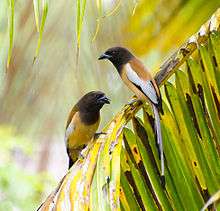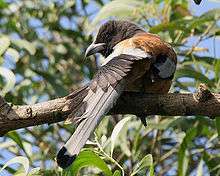Rufous treepie
| Rufous treepie | |
|---|---|
 | |
| Scientific classification | |
| Kingdom: | Animalia |
| Phylum: | Chordata |
| Class: | Aves |
| Order: | Passeriformes |
| Family: | Corvidae |
| Genus: | Dendrocitta |
| Species: | D. vagabunda |
| Binomial name | |
| Dendrocitta vagabunda (Latham, 1790) | |
| Synonyms | |
|
Dendrocitta rufa | |
The rufous treepie (Dendrocitta vagabunda) is a treepie, native to the Indian Subcontinent and adjoining parts of Southeast Asia. It is a member of the crow family, Corvidae. It is long tailed and has loud musical calls making it very conspicuous. It is found commonly in open scrub, agricultural areas, forests as well as urban gardens. Like other corvids it is very adaptable, omnivorous and opportunistic in feeding. In Bengali and some other Indian languages it is called "Harichacha" (হাঁড়িচাচা), after the unpleasant sound it produces.
Description

The sexes are alike and the main colour of the body is cinnamon with a black head and the long graduated tail is bluish grey and is tipped in black. The wing has a white patch. The only confusable species is the grey treepie which however lacks the bright rufous mantle. The bill is stout with a hooked tip. The underparts and lower back are a warm tawny-brown to orange-brown in colour with white wing coverts and black primaries. The bill, legs and feet are black.[2]
The widespread populations show variations and several subspecies are recognized. The nominate subspecies is found in the northeastern part of peninsular India south to Hyderabad. The desert form is paler and called pallida, vernayi of the Eastern Ghats is brighter while parvula of the Western Ghats is smaller in size.[2] The form in Afghanistan and Pakistan is bristoli while the form in southern Thailand is saturatior. E C Stuart Baker describes sclateri from the upper Chindwin to the Chin Hills and kinneari from souther Myanmar and northwest Thailand.[3] The population in eastern Thailand an Indochina is sakeratensis.[4]
Distribution
The range of this species is quite large, covering all of mainland India up to the Himalayas, and southeasterly in a broad band into Burma (Myanmar), Laos, and Thailand in open forest consisting of scrub, plantations and gardens. There is only one verity of Indian Treepie in Indian Institute of Science Education and Research(IISER) Mohali. Mr. Ankit Labh is working on this bird. One can see it in the IISER-M Campus near CAF Building, Near Visitor's guest house and back of Hostel-6. It is not as common as domestic crow but one can find. It is seen usually during Morning and Evening. It is found in large numbers in the Fig tree at Sri Vittal Rukmini Samsthan, Govindapuram, Kumbakonam. It is also found in SBOA School campus, Nagamalai,CAS Marine biology Annamalai university, Madurai.
Behaviour and ecology

The rufous treepie is an arboreal omnivore feeding almost completely in trees on fruits, seeds,[5] invertebrates, small reptiles and the eggs and young of birds;[6] it has also been known to take flesh from recently killed carcasses. It is an agile forager, clinging and clambering through the branches and sometimes joining mixed hunting parties along with species such as drongos and babblers. It has been observed feeding on ecto-parasites of wild deer.[7] Like many other corvids they are known to cache food.[8] They have been considered to be beneficial to palm cultivation in southern India due to their foraging on the grubs of the destructive weevil Rhynchophorus ferrugineus.[9] They are known to feed on the fruits of Trichosanthes palmata which are toxic to mammals.[10]
The breeding season in India is April to June. The nest is built in trees and bushes and is usually a shallow platform. There are usually 3-5 eggs laid.[11][12]
This species has a wide repertoire of calls, but a bob-o-link or ko-tree call is most common.[2] A local name for this bird kotri is derived from the typical call while other names include Handi Chancha and taka chor (="coin thief").[10][13]
A blood parasitic protozoan Trypanosoma corvi has been described from this species[14] and Babesia has been reported from this species.[15] Trematode parasites, Haplorchis vagabundi, have been found in their intestines.[16] A species of quill mite Syringophiloidus dendrocittae has been described from this species.[17]
References
- ↑ BirdLife International (2012). "Dendrocitta vagabunda". IUCN Red List of Threatened Species. Version 2013.2. International Union for Conservation of Nature. Retrieved 26 November 2013.
- 1 2 3 Rasmussen, PC & JC Anderton (2005). Birds of South Asia: The Ripley guide. Volume 2. Smithsonian Institution & Lynx Edicions. p. 595.
- ↑ Baker, EC Stuart (1922). The Fauna of British India, Including Ceylon and Burma. Birds. Volume 1. Taylor and Francis, London. pp. 48–52.
- ↑ Dickinson, E.C., R.W.R.J. Dekker, S. Eck & S. Somadikarta (2004). "Systematic notes on Asian birds. 45. Types of the Corvidae". Zool. Verh. Leiden 350: 111–148.
- ↑ Sharma,Satish Kumar (1992). "Tree Pie Dendrocitta vagabunda (Latham) feeding on aril of seeds of Pithecellobium dulce". J. Bombay Nat. Hist. Soc. 89 (3): 374.
- ↑ Begbie,A (1905). "Curious ferocity of the Indian Tree-pie Dendrocitta rufa". J. Bombay Nat. Hist. Soc. 16 (3): 502–503.
- ↑ Bharucha,EK (1987). "An observation on the relationship between a Sambar and a Tree-Pie". J. Bombay Nat. Hist. Soc. 84 (3): 675.
- ↑ de Kort, Selvino R & Nicola S. Clayton (2006). "An evolutionary perspective on caching by corvids". Proceedings of the Royal Society B 273 (1585): 417–423. doi:10.1098/rspb.2005.3350. PMC 1560201. PMID 16615207.
- ↑ Krishnakumar R., Sudha G. (2002). "Indian tree pie Dendrocitta vagabunda parvula (Whistler and Kinnear) (Corvidae). A predatory bird of red palm weevil Rhynchophorus ferrugineus (Oliv.)". Insect Environment 8: 133.
- 1 2 Ali, S & SD Ripley (1986). Handbook of the birds of India and Pakistan. Volume 5 (2 ed.). Oxford University Press. pp. 216–221.
- ↑ Whistler, Hugh (1949). Popular Handbook of Indian Birds. 4th Edition. Gurney and Jackson. pp. 12–14.
- ↑ Hume, AO (1889). The nests and eggs of Indian birds. Volume 1. R H Porter, London. pp. 19–22.
- ↑ Finn, Frank (1904). The Birds of Calcutta. Thacker, Spink & co. pp. 10–13.
- ↑ Nandi N. C., Bennett G. F. (1994). "Re-description of Trypanosoma corvi Stephens and Christophers, 1908 emend Baker, 1976 and remarks on the trypanosomes of the avian family Corvidae". Mem. Inst. Oswaldo Cruz 89 (2): 145–151. doi:10.1590/S0074-02761994000200005.
- ↑ Peirce MA (2000). "A taxonomic review of avian piroplasms of the genus Babesia Starcovici, 1893 (Apicomplexa: Piroplasmorida: Babesiidae)". J. Nat. Hist. 34 (3): 317–32. doi:10.1080/002229300299507.
- ↑ Baugh, S.C. (1963). "Contributions to our knowledge of digenetic trematodes VI". Parasitology Research 22 (4): 303–315. doi:10.1007/BF00260191. PMID 13966962.
- ↑ Fain A; Bochkov, A.; Mironov, S. (2000). "New genera and species of quill mites of the family Syringophilidae (Acari, Prostigmata)". Bulletin van het Koninlijk Belgisch Instituut voor Natuurwetenschappen - Entomologie 70: 33–70.
External links
| Wikimedia Commons has media related to Dendrocitta vagabunda. |
| Wikispecies has information related to: Dendrocitta vagabunda |

